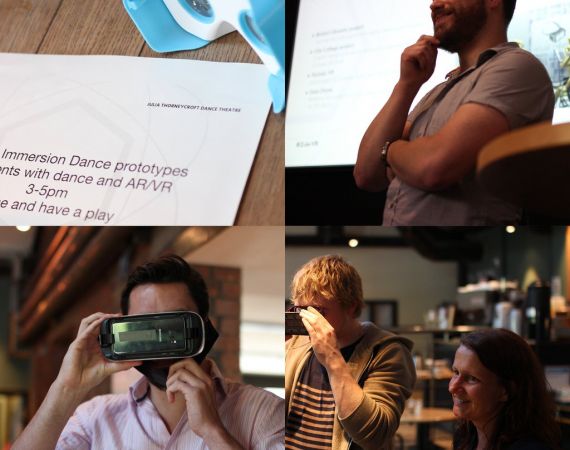Lunchtime talk write-up
Posted on Tue 14 Jun 2016
Immersion Dance
Jack from Zubr Reality and Julia from Julia Thorneycroft Dance Theatre joined forces to collaborate on an experimental project testing new ways to present dance in virtual and augmented reality.

Image from Zubr VR
Jack from Zubr Reality and Julia from Julia Thorneycroft Dance Theatre joined forces to collaborate on an experimental project testing new ways to present dance in virtual and augmented reality. Immersion Dance has adopted a playful trial and error process; testing out multiple possibilities quickly and sharing short prototypes dance films early. Here are five things I learned:
1. Immersion Dance uses depth-sensing cameras and 3D scanners to film short dance pieces. Jack and Julia initially trialled motion capture, but found that as the data was filtered to specific joints, the dancer’s body, as a whole, was lost. One of their primary aims is to maintain an emotional connection between the dancer and the audience in the digital experience and to retain the sensation of a live performance.
2. Making dance more accessible and finding new audiences are both core ambitions of the project. Mixing dance and VR or AR has the potential to engage new intergenerational audiences. The pieces created are accessible at home from an armchair, with the use of a smartphone and VR headset.
3. Jack and Julia have created five dance pieces, from a duet performed around a can of baked beans to one piece featuring a dancer rendered as fairy-dust particles. This process of rapid prototyping throws up a number of challenges. In one of the Immersion Dance pieces, the audience viewpoint was positioned too close to the dancer which gave the perception that the dancer was kicking the audience in the face – while this might be a great feature for some immersive experiences it was not the desired effect here!
4. Julia had several choreographic challenges to overcome, most significantly directing the audience’s position and gaze in relation to the dancer. In a physical performance space, there is a fourth wall (the invisible wall between the audience and the performers). When relating this to AR, the fourth wall can be anywhere, including above the audience. In VR, there is no fourth wall; the audience can be placed anywhere in relation to the dancer and can be looking in any direction.
5. Jack and Julia are applying their learning’s from Immersion Dance over the next couple of months to future projects with At-Bristol, the Data Dome and Bristol Libraries. In the future they hope to explore the possibilities of game mechanics by offering the audience control over the content and how they interact with it.
Following the talk, Jack and Julia set up their prototypes for informal play testing in the Watershed café/bar. Thanks to everyone who came and had a go.